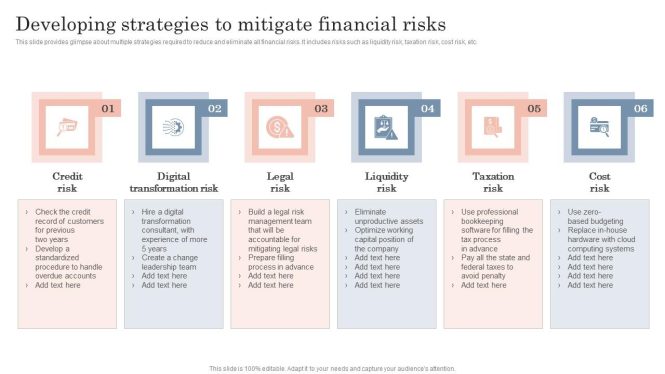

Strategies for Managing Financial Risks in the Construction Industry are essential for project success. A well-planned approach to financial risk management can dramatically affect profitability and on-time completion. Financial risks are inherent in the construction industry, stemming from fluctuating material costs, unpredictable weather delays, and labor disputes. These risks can lead to significant financial losses if not adequately addressed. This article explores key strategies to manage financial risks in construction projects, from meticulous budgeting to proactive contingency planning, and will detail effective techniques and examples to help construction companies protect their bottom line and ensure project longevity.
Identifying and Assessing Potential Risks
Understanding the Spectrum of Construction Risks
Construction projects are inherently complex, involving various stakeholders, diverse materials, and unpredictable circumstances. Project managers must proactively identify and assess potential risks before initiating a project. This involves considering a range of variables, including material price fluctuations, changes in labor costs, permitting delays, and weather-related disruptions. A thorough risk assessment allows construction firms to understand the potential magnitude of each risk and its likelihood of occurrence. For example, a new construction project in an area prone to hurricanes may require significant contingency plans to mitigate potential losses.
Developing a Robust Budget and Financial Plan
Establishing Realistic Budgets and Forecasting Revenue
Creating a realistic and detailed budget is paramount to effective financial risk management. The budget should consider not only material and labor costs but also potential contingencies for unexpected expenses, such as repairs, delays, and insurance claims. Accuracy in forecasting revenue is equally critical; understanding and projecting potential income from contracts, payments, and anticipated profit margins is crucial to make sound financial decisions. A critical example of this is the construction of a complex skyscraper that requires careful planning for contingencies such as delays due to material shortages or weather events.
Implementing Effective Cost Control Measures
Proactive Monitoring of Expenses and Materials
Consistent monitoring of project costs is essential to identify deviations from the budget early. This includes regular cost analysis of material usage, labor hours, and other expenses. Tools and techniques, including project management software, allow construction companies to track expenses in real-time, enabling prompt corrective actions. For instance, a construction company noticing material costs escalating beyond the budgeted amount can take proactive measures to negotiate better prices with suppliers or explore alternative materials to stay within budget.
Utilizing Contingency Planning and Risk Mitigation Strategies
Creating Contingency Plans for Unforeseen Events
Proactive contingency planning is a critical strategy for minimizing the impact of unforeseen events. This involves developing alternative plans and strategies for dealing with potential problems, including delays, cost overruns, or material shortages. Effective contingency planning includes detailed procedures to handle various situations, ensuring the project stays on track despite unexpected challenges. An example would be developing a contingency plan for material shortages, which could involve alternative sourcing strategies and expedited delivery arrangements.
Leveraging Insurance and Risk Transfer Mechanisms
Seeking Appropriate Insurance Coverage
Appropriate insurance coverage is a vital risk mitigation strategy for construction firms. This protection can cover various potential risks, such as property damage, accidents, delays, and financial losses. Insurance acts as a safety net to ensure project continuity and financial stability in case of an unforeseen incident. A good example of this is purchasing comprehensive general liability insurance to protect against claims arising from accidents on the construction site or damage to property.
How can technology help in managing financial risks in the construction industry?
Technology plays a significant role in managing financial risks in the construction industry. Utilizing project management software enables real-time tracking of project expenses, progress, and budget adherence. This helps in identifying deviations from the budget early, allowing for quick corrective actions. Financial forecasting software assists in predicting potential financial risks and their impact on project timelines and budgets. Mobile apps enable construction workers to submit expense reports efficiently, improving cost control and accountability.
What are some common pitfalls to avoid when developing a financial risk management plan?
One common pitfall is underestimating the potential risks associated with the project. A comprehensive risk assessment is crucial to identify all potential hazards. Another common error is failing to create a contingency plan for unexpected events. Thorough planning is vital for handling unforeseen circumstances. Not seeking expert advice from professionals or failing to account for the latest industry trends and best practices can also lead to ineffective plans.
Frequently Asked Questions
What are the key steps in developing a strong financial risk management plan for a construction project?
Developing a robust financial risk management plan for a construction project involves several key steps. First, identify potential risks and assess their likelihood and impact. Next, create a realistic budget and forecast revenue to track spending and income. Implement strategies for cost control and monitoring, such as utilizing project management software to track project expenses. Establish contingency plans for various scenarios, outlining alternative solutions for handling unforeseen events. Finally, consider appropriate insurance and risk transfer mechanisms to protect the project against various potential liabilities.
In conclusion, effectively managing financial risks in construction projects is crucial for profitability and project success. By implementing the strategies outlined above, construction companies can mitigate potential threats, improve cash flow management, and ultimately, achieve better outcomes. We encourage you to implement these strategies in your projects, and if you need help, consult with financial experts or professionals to further refine your risk management plan. Remember to stay proactive and adapt to changes in the market.